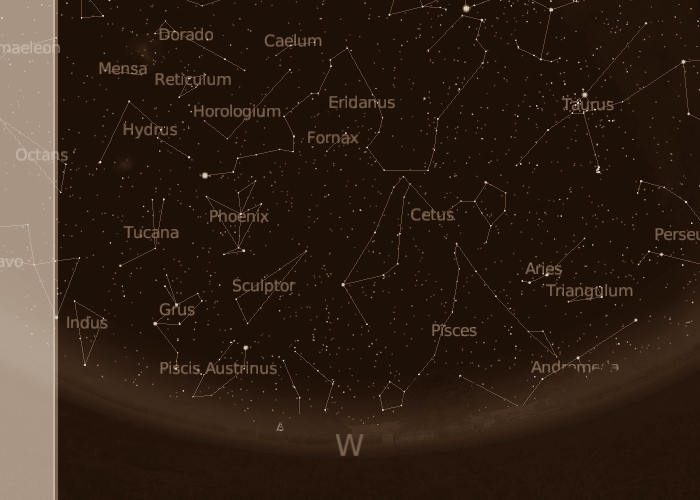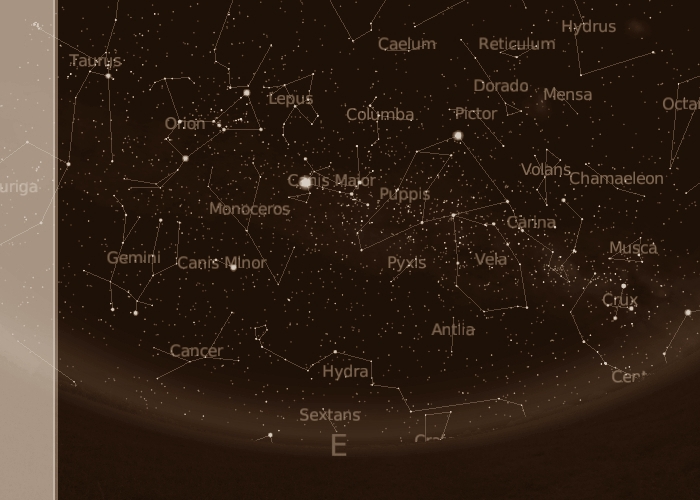Western Horizon
Eastern Horizon
![]()
Western Horizon
Eastern Horizon

It's summer! The summer sky, in the southern hemisphere, allows to have, on the northern horizon, the fine sight of some great views, which, North, are typical of the winter nights. As far as the western horizon is concerned, the sky may be considered relatively faint there. You will find back Cetus, the Whale, as the constellation is anchored to the first bent, high, of Eridanus, the River Eridanus. Albeit low somehow, Pisces, the Fishes, are fine as the southwestern part of the sky is featuring the bright Achernar -to where Eridanus is ending its course, along with some typical southern constellations -like Phoenix, the Phoenix, or Tucana, the Toucan- along with the Small Magellanic Cloud. Fomalhaut is still seen, low. to a printer-friendly chart
West for the tropics. West for the mid-northern latitudes

First of all, let's turn to the northern horizon! Albeit the skies, in the southern hemisphere, are not devoided of numerous jewels and fine sights, it's there, during summer, that you'll be able to see another fine part of the sky. It's what's called the 'great winter sky', as those bright stars, and fine constellations there, are the distinctive feature of the winter sky, in the northern hemisphere! The central figure of it is the famed constellation Orion, the Hunter. Orion, is this large quadrilateral of stars, high, as three stars are aligned in its center. Orion was a famed, ancient hunter, the Greek goddess of the Moon and the hunt had killed through a scorpion. That's the reason why Orion, and the Scorpion, just occupy both the opposites sides of the sky... The three stars are termed the 'Orion's Belt', as, above them, the faint -albeit well seen- spot is the famed Orion Nebula -M42. Some alignments from Orion allow to find the other constellations and stars of the sky. Should you extend the line of the Orion's Belt downwards and left, you'll find Aldebaran, and Taurus. A little further, and that's the famed Pleiades! The Orion's Belt again, this time upwards and right, and it's Sirius, the sky's brightest star, and Canis Major, the Great Dog, high. Consider then a line joining the upper left star of the quadrilateral -that's Rigel- and the lower right one -that's Betelgeuse- and extend it down and right. The other large quadrilateral there are Gemini, the Twins. The bright star to their upper right is Procyon, of Canis Minor, the Little Dog, as the bright star, which hangs few high above the horizon, is Capella, of Auriga, the Charioteer. A fine sky! The East now, proper! At the opposite of what was seen in winter, it's southeast that you'll find the band of the Milky Way-embedded, typical southern constellations. As they begin with Centaurus, the Centaur, the band eventually reconnect with the northern part of the Milky Way in the region of Canis Major and Sirius! In-between, that's the constellations which had been born in the 18th century when astronomers parted the ancient and vast Argo, the Ship. Crux, the Southern Cross, is seen too. More are to come, as Cancer, the Crab, with the famed M44, this open cluster, and the long and fine chain of Hydra, the Hydra, are going to get better and better positioned, offering other fine views. to a printer-friendly chart
East for the tropics. East for the mid-northern latitudes
(color maps with Stellarium; printer-friendly charts with Cartes du Ciel, Patrick Chevalley)
Website Manager: G. Guichard, site 'Amateur Astronomy,' http://stars5.6te.net. Page Editor: G. Guichard. last edited: 12/28/2010. contact us at ggwebsites@outlook.com